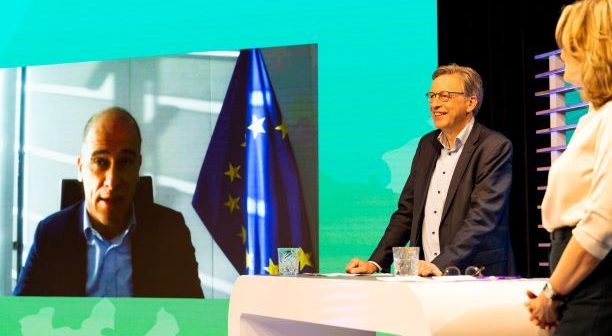By 2030, let’s do everything we can to completely eliminate the world’s 51 billion tonnes of CO2 emissions by 2050. Not by small easy steps, but by investing in electrification and in real technological breakthroughs. And yes, innovation and scaling up will initially require considerable support from governments. Bill Gates writes this in his latest book How to Avoid a Climate Disaster: The Solutions We Have and the Breakthroughs We Need. This is exactly how Economisch Netwerk Zuid-Nederland(ENZUID) envisages and approaches the issue in the programme ‘Green Chemistry, New Economy,’ aimed at the plastics and artificial fertiliser industry. The ambitious Action Agenda ‘Green Chemistry, New Economy’ was recently presented.

Guustaaf Savenije van VDL Groep.
The presentation of the action programme for manufacturing chemistry was online, but that did not prevent new alliances being forged. Board member Guustaaf Savenije of VDL Groep announced that he will certainly talk with general manager of corporate sustainability Frank Kuijpers of SABIC and with chairman of the board Anton van Beek of DOW Benelux. SABIC is investigating pyrolysis of plastic waste to replace fossil fuels. DOW is working with the steel industry on a new value chain where released CO2 is converted into raw material. During the meeting, Savenije says: ‘Let’s get our system engineers together and see what we can do together. We are eager to get to grips with this, people are intrinsically motivated to work on sustainability issues. What role do we want to play: OEM, main supplier, integrator – it doesn’t matter. We’re still rookies in the field of chemistry, but delivering smart systems is our daily work.’ There is no time to lose. Van Beek adds: ‘Our task is simple: we must continue to make products for society, without CO2 and circularly.’ DOW Terneuzen will be the flagship for innovation for the multinational. ‘And not just with some pilot projects, but really on a large scale.’

general manager of corporate sustainability Frank Kuijpers of SABIC
Manufacturing Chemistry Action Agenda
Last year Economisch Netwerk Zuid-Nederland (ENZuid) published the project initiation document ‘Green Chemistry, New Economy – Chain Transition in the Process Industry’. Founded in early 2020, ENZuid is a strategic partnership of eight triple helix regions and the provinces of Zeeland, Noord-Brabant and Limburg. It seeks to generate business from innovation and was the first to embrace the major theme of greening the chemical process industry in the south of the Netherlands. This has now resulted in the Action Agenda ‘Green Chemistry, New Economy’ (see box), with agenda number 1 being the creation of a national innovation platform for scaling up circular raw materials and disruptive technologies in the manufacturing chemistry. The agenda focuses on the south of the Netherlands with its major manufacturing sites Moerdijk, Terneuzen and Chemelot. But it is of national importance, stresses Arnold Stokking, CEO of Brightsite, a partnership of Brightlands Chemelot Campus, Sitech Services, Maastricht University and TNO, and driving force from ENZuid.

chairman of the board Anton van Beek of DOW Benelux
Momentum is now
He and his booster team have recently been putting their heart and soul into drawing up the agenda. ‘The government and the business community are very busy with wind farms, infrastructure, green hydrogen, you name it. But there is now momentum to also look at what we can do together to replace oil and gas as a raw material, not just as a fuel.’ Although the vast majority of oil and gas is used for energy and fuels, the process industry still accounts for about 15 percent of oil and gas use. Stokking says: ‘Over the past decades, the chemical industry has optimised a great deal and the enormous process installations are state-of-the-art, which is wonderful. But in order to achieve the climate targets, we need to start innovating as a matter of urgency, and to supply manufacturing chemistry with new processes and raw materials.’ The required technology on both the raw materials side and the green electricity side is in principle available from universities, institutes but has occasionally also been applied experimentally by companies. Sectors must join forces to scale up innovations.

Emmo Meijer, former CTO of DSM
Opportunities in a variety of sectors
In the Climate Act, the Netherlands has laid down that by 2030 CO2 emissions must be 49 percent less than in 1990. The Climate Agreement between government, businesses and civil-society organisations is based on this target. By 2050 emissions must be 95 percent less than in 1990. And 2030 and 2050 are not far off, according to Emmo Meijer, former CTO of DSM and now standard bearer of the Chemicals Top Sector, also speaking on behalf of the Energy and High Tech Systems & Materials top sectors. ‘These are big ambitions, but sustainable development must be possible given all the technological options. We now need to use demonstration projects to show that it is all possible, as an intermediate step towards large commercial installations. The process industry is distinctly cross-sectoral. This green chemistry calls for new equipment, new materials, sustainable energy and process innovation.’ The opportunities for the chemical industry, the high-tech manufacturing industry, the agricultural sector and the recycling sector are there for the taking.

Focco Vijselaar, Director-General of Business and Innovation at the Ministry of Economic Affairs & Climate
Economic potential
A wide range of companies, authorities, lenders and interest groups support the goal of the ‘Green Chemistry, New Economy’ Action Agenda. This so-called Coalition, including SABIC, DOW, Cosun, VDL, TNO, BOM, LIOF, Brainport Industries, Chemelot, Brightsite, Moerdijk Port Authority, FME and VNCI, is taking on the implementation of the agenda. In the coming years, parties can work together on green technology that can then be rolled out on a large scale in the 2030-2050 period. The Netherlands is bound to enter the global market successfully with it as well. ‘We are talking about sustainability, but also about great economic potential,’ says Focco Vijselaar, Director-General of Business and Innovation at the Ministry of Economic Affairs & Climate. ‘Clean cuts costs, is a magnet for new staff and reduces long-term business risks.’ The government is going to remove impeding regulations and already has numerous incentive measures in place, according to Vijselaar.
Money needed

Diederik Samsom
The Action Agenda focuses on four cross-sectoral greening directions: biomass as a raw material, waste as a raw material and CO2 as a raw material for the chemical industry, and new green electricity-based processes such as electrolysis and plasma technology. A number of scaling-up projects have already been launched (see box). Arnold Stokking says: ‘The question is, of course, how to finance all this and create a sound business case. We compete with a highly efficient oil and gas industry. Investments pay for themselves only after a long time. But we know there is light at the end of the tunnel. CO2 pricing will make gas and oil more expensive. It is also becoming increasingly clear that consumers no longer accept this pollution. Financial institutions are giving more and more priority to sustainability. It’s going to happen, but we have to tide over a period of time.’ Companies cannot do this alone; the government and financial institutions must cooperate; incentives and better instruments are needed if the raw materials transition is to take place alongside the energy transition.

Arnold Stokking, CEO of Brightsite
Many sources of money
But that is going to be fine, says Diederik Samsom, head of cabinet to EU Commissioner Frans Timmermans. ‘We’re working on that huge Green Deal, one comprehensive roadmap for circularity and sustainability. I clearly sense that the industry is aware that we cannot rely on small steps forward. Big steps require huge investments and a lot of guts from entrepreneurs. And from the public parties. The Green Deal costs 750 billion euros, 5.6 billion of which specifically for the Netherlands. Most of it has to go into climate investments to complete the business cases.’
There are many sources of money, tap into them, says CEO Wouter Bos of Invest-NL (budget 1.7 billion). ‘As Invest-NL we forge coalitions. And we invest through participations and subordinated loans. If there is one place where it is needed, it is in the transition to a carbon-neutral, circular economy. It is still an accumulation of uncertainties: Traditional market parties all want to do something, but it takes money.’
The complete transition to sustainable raw materials and green, electric processes within the basic chemical industry will ultimately lead to a reduction in CO2emissions of 40 million tonnes per year from the chemical industry in the south of the Netherlands by 2050, according to calculations made by Brightsite.
Scaling up can start

DOW Terneuzen will be the flagship for innovation for the multinational. ‘And not just with some pilot projects, but really on a large scale,’ says chairman of the board Anton van Beek. Photo: DOW
The ‘Green Chemistry, New Economy’ Action Agenda lists a whole series of scaling-up projects. These must show that disruptive innovations contribute to the climate targets and that large-scale application is ultimately possible. What developments are underway?
- Application of new innovative electrolysis to produce green hydrogen in a cost-efficient way, with companies from the chemical, energy and HTSM sectors working together. In February 2021, FME and TNO set up an electrolyser developer platform that aims to run a pilot project with a 1-2 MW electrolyser within three years. Forty Dutch high-tech companies want to participate in this platform.
- Carbon Capture and Utilisation: Alta Carbon Technologies has developed a cleaner, highly scalable technology with higher energy efficiency. Residual CO2 is converted into high quality carbonates. The carbonates are, for example, suitable as raw material for the fast-growing battery industry. Alta Carbon expects to use ten megatonnes of CO2 per year in chemical products in about twelve years.
- Production of hydrogen and ethylene using plasma technology. At Chemelot, hydrogen is an important raw material for the production of ammonia and fertiliser by chemical company OCI Nitrogen. Ethylene is the basic raw material for the production of plastics by SABIC, also at Chemelot.
- Biobased raw materials as a sustainable feedstock for the chemical industry. Two industrial chain players, Maastricht University, TNO and Bio Transitie Consultants are setting up a processing chain to supply the chemical industry with biobased raw materials such as sugar beet, grains and elephant grass.
- Breaking down plastic waste through highly innovative and efficient gasification technology that Synova Power is working on.
Scaling up can start
The ‘Green Chemistry, New Economy’ Action Agenda lists a whole series of scaling-up projects. These must show that disruptive innovations contribute to the climate targets and that large-scale application is ultimately possible. What developments are underway?
- Application of new innovative electrolysis to produce green hydrogen in a cost-efficient way, with companies from the chemical, energy and HTSM sectors working together. In February 2021, FME and TNO set up an electrolyser developer platform that aims to run a pilot project with a 1-2 MW electrolyser within three years. Forty Dutch high-tech companies want to participate in this platform.
- Carbon Capture and Utilisation: Alta Carbon Technologies has developed a cleaner, highly scalable technology with higher energy efficiency. Residual CO2 is converted into high quality carbonates. The carbonates are, for example, suitable as raw material for the fast-growing battery industry. Alta Carbon expects to use ten megatonnes of CO2 per year in chemical products in about twelve years.
- Production of hydrogen and ethylene using plasma technology. At Chemelot, hydrogen is an important raw material for the production of ammonia and fertiliser by chemical company OCI Nitrogen. Ethylene is the basic raw material for the production of plastics by SABIC, also at Chemelot.
- Biobased raw materials as a sustainable feedstock for the chemical industry. Two industrial chain players, Maastricht University, TNO and Bio Transitie Consultants are setting up a processing chain to supply the chemical industry with biobased raw materials such as sugar beet, grains and elephant grass.
- Breaking down plastic waste through highly innovative and efficient gasification technology that Synova Power is working on.

Theo Kneepkens
(KLA) about supercycle of growth: Í hope that supply industry expands its capacity’. Read this edition of link magazine digitally via this link
22 actions to make manufacturing more sustainable
ENZuid has laid down no fewer than 22 actions in its ‘Green Chemistry, New Economy’ Action Agenda. To name a few:
- Establish a national innovation platform for scaling up circular raw materials and disruptive technologies in the manufacturing industry.
- Formulate ‘all-encompassing’ transition scenarios for manufacturing chemistry.
- Develop cross-sectoral system roadmaps for the raw materials transition in manufacturing chemistry.
- Initiate cross-sector coalitions and organise leadership.
- Develop new, collaborative business models, focused on transitions.
- Engage in hybrid/co-financing strategies for scaling up.
- Examine how ‘social value’ can be included in investment decisions.
- Work on a paradigm shift in legislation and regulations. For example, look at impeding waste legislation and regulations.
- Invest in talent for ‘Green Chemistry, New Economy’.






